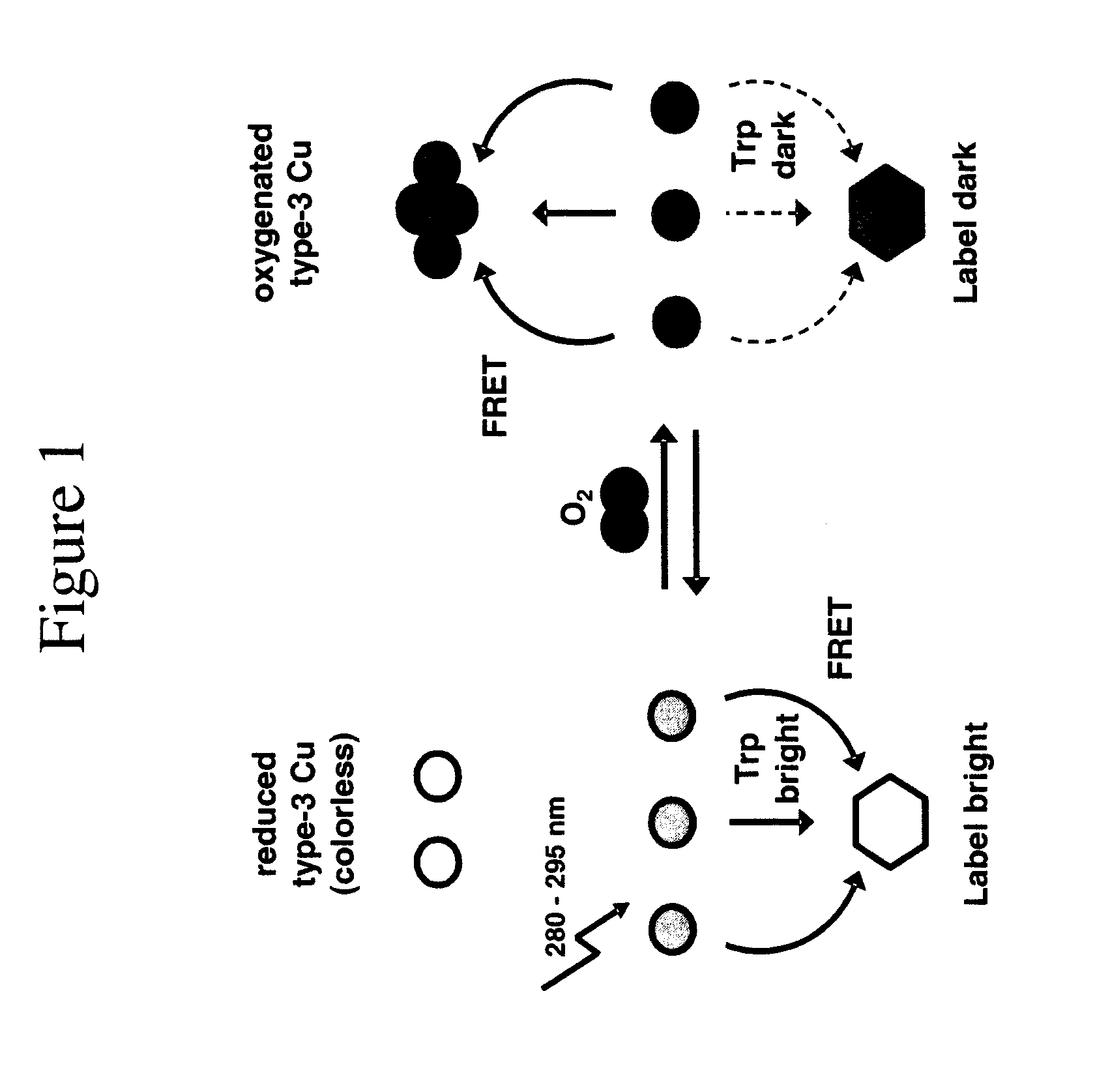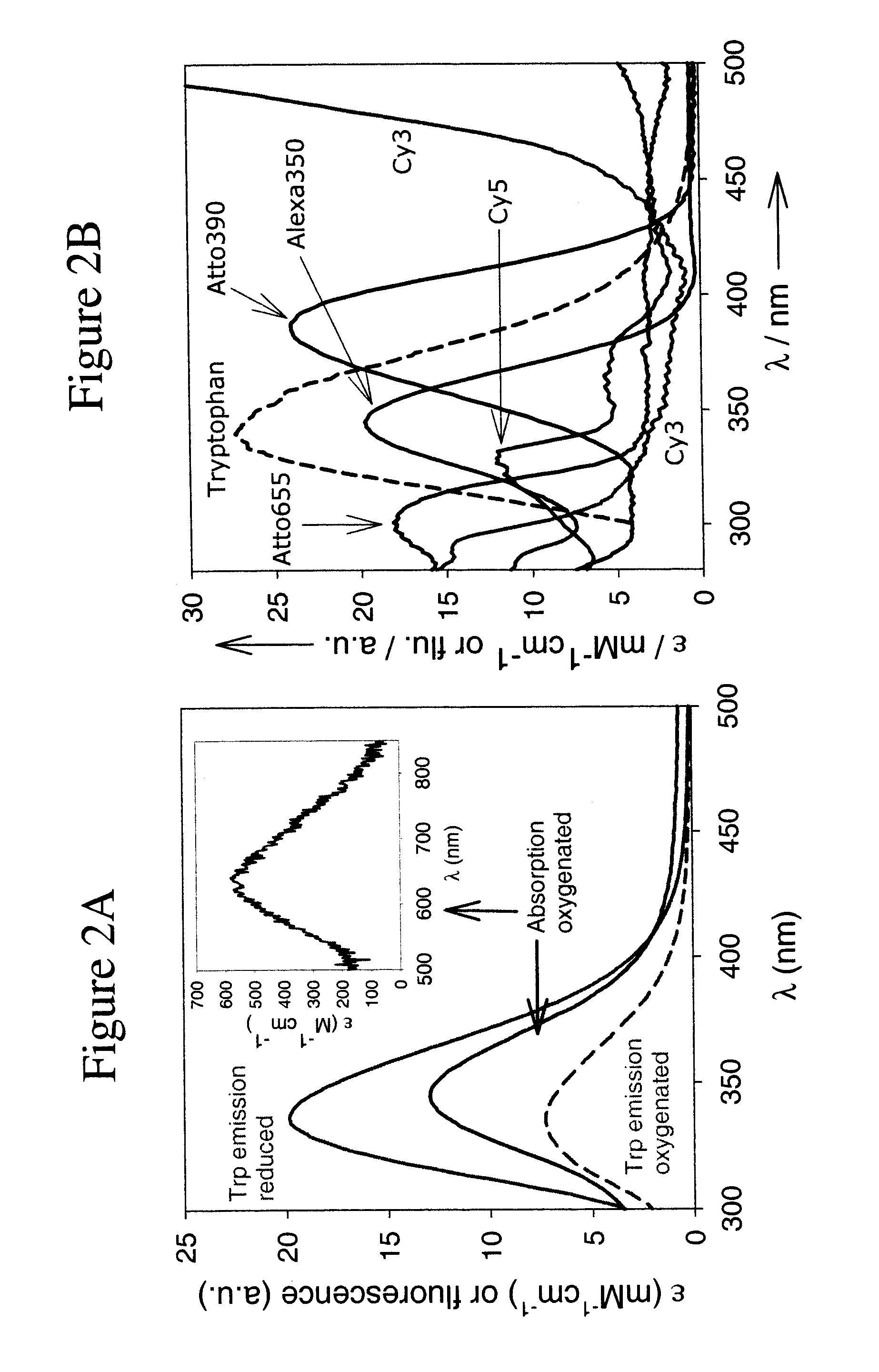Immobilisation of fluorescent proteins
a fluorescent protein and protein technology, applied in the field of fluorescent resonance energy transfer, can solve the problems of changing the oxygen concentration in the sample, requiring encapsulation in a hydrophobic matrix, and further limiting the application of both types of sensors, so as to achieve enhanced quenching, gain in quantum yield of fluorescence, and sensitivity.
- Summary
- Abstract
- Description
- Claims
- Application Information
AI Technical Summary
Benefits of technology
Problems solved by technology
Method used
Image
Examples
example 1
Protein Trp Fluorescence and O2 Binding (Reference)
[0109]To illustrate this Example, Ty from the soil bacterium Streptomyces antibiotius was selected.
[0110]S.c. Ty contains 12 Trp residues on a total of 271 amino-acids (4.4% against ˜1% on average [10]), which cluster around the type-3 centre. The Trp fluorescence shows a maximum at 339 nm upon excitation at 280 nm. In an air-saturated solution (0.26 mM O2), practically all protein occurs in the oxygenated form (see FIG. 2A). Upon complete deoxygenation, the Trp fluorescence increases by a factor of 2.7 while the shape and position of the emission band remain unchanged. For the C.a. Hc samples, this factor, further referred to as the switching ratio SR (=Fred / Foxy), amounts to 2.2.
example 2
Dyes (Reference)
[0111]FIG. 2B shows absorption spectra between 250 and 500 nm of the five dyes selected for this study: Alexa350, Atto390, Cy3, Cy5 and Atto655, as well as their overlap with the Ty tryptophan emission. The excitation wavelength was 280 nm. Together these dyes emit at wavelengths spanning the whole visible spectrum (Table 2 and FIG. 2B). This allows the researcher to choose a dye which emits at a wavelength which does not interfere with other fluorescent systems in the sample.
TABLE 2Switching ratios, spectral overlap integrals and Förster radii forTrp and the dyes utilised in this study.Ro, TrpλemSR[a]SR[a]Jtrp Ty[b]Ty[c]Dyes(nm)TyrHc(nm4M−1 cm−1 × 10−13)(Å)Trp3392.72.213.023Alexa3504401.82.416.524Atto3904702.22.121.125Cy35662.82.25.920Cy56654.22.35.820Atto6556844.32.17.221[a]denotes the dye emission switching ratio (Fred / Foxy) observed with excitation at 280 nm.[b]Calculated spectral overlap integrals between the Trp emission and the absorption of the oxygenated pro...
example 3
Reference
O2 Binding and Label Fluorescence
[0113]Excitation absorption spectrums were recorded in this Example using a monochromator in the detection path, that has its wavelength set at an emission band of the molecule to be studied, in this case 660 nm for Cy5. Excitation is achieved by using a white light source and employing a second monochromator between light source and sample. The wavelength of this monochromator was slowly scanned. When the wavelength of the excitation light matched an absorption band of Cy5, the dye started to fluoresce (at 660 nm) and the emitted light was observed in the detection set-up. By recording the fluorescence intensity as a function of the wavelength of the exciting light, the absorption spectrum was obtained.
[0114]Both Hc and Ty were labelled at their N-terminus with each of the five dyes [12]. When setting the detection wavelength at the dye emission maximum, the excitation spectra of the labelled proteins exhibit a strong peak at 280 nm, i.e., ...
PUM
| Property | Measurement | Unit |
|---|---|---|
| wavelength | aaaaa | aaaaa |
| wavelength | aaaaa | aaaaa |
| wavelength | aaaaa | aaaaa |
Abstract
Description
Claims
Application Information
 Login to View More
Login to View More - R&D
- Intellectual Property
- Life Sciences
- Materials
- Tech Scout
- Unparalleled Data Quality
- Higher Quality Content
- 60% Fewer Hallucinations
Browse by: Latest US Patents, China's latest patents, Technical Efficacy Thesaurus, Application Domain, Technology Topic, Popular Technical Reports.
© 2025 PatSnap. All rights reserved.Legal|Privacy policy|Modern Slavery Act Transparency Statement|Sitemap|About US| Contact US: help@patsnap.com



